INF30029 - Project Management: Analysis of Google Glass Project
VerifiedAdded on 2022/09/14
|10
|2531
|22
Report
AI Summary
This report provides a detailed analysis of the Google Glass project, evaluating its success and failure based on several criteria. The report examines the transformation of the initial idea into an actual product, assessing the effectiveness of the business plan and the identification of the target market. It also analyzes the quality of the product, addressing design flaws, user experience issues, and concerns related to security, health, privacy, and ethical aspects. Furthermore, the report evaluates the project's performance in the market, considering sales figures and the ultimate decision to discontinue the product. The report concludes with recommendations, emphasizing the importance of defining project scope, creating a robust business plan, focusing on product benefits, and implementing rigorous quality control measures. The analysis highlights the importance of effective planning and execution of strategies for project success, even with a visionary idea.
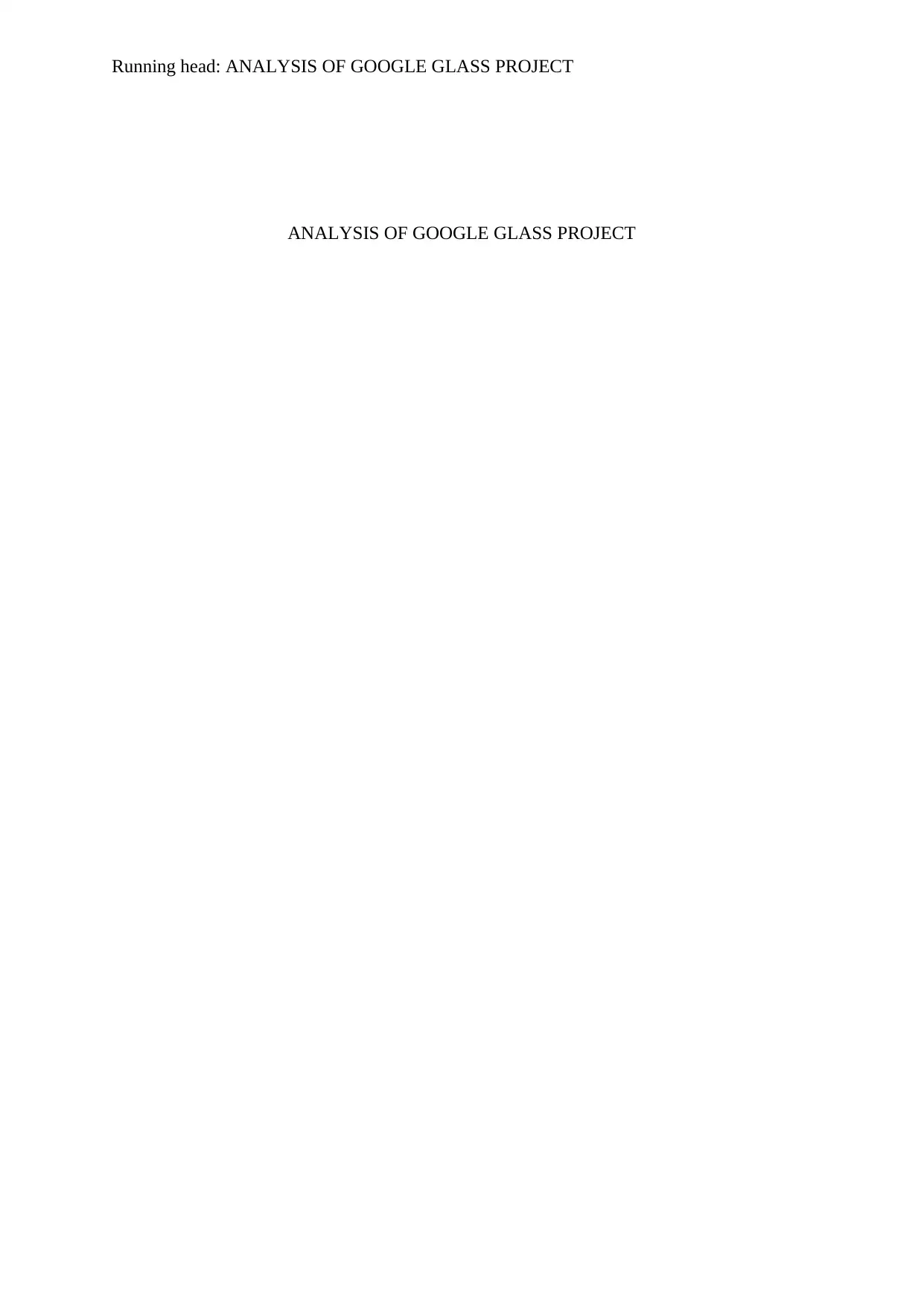
Running head: ANALYSIS OF GOOGLE GLASS PROJECT
ANALYSIS OF GOOGLE GLASS PROJECT
ANALYSIS OF GOOGLE GLASS PROJECT
Paraphrase This Document
Need a fresh take? Get an instant paraphrase of this document with our AI Paraphraser
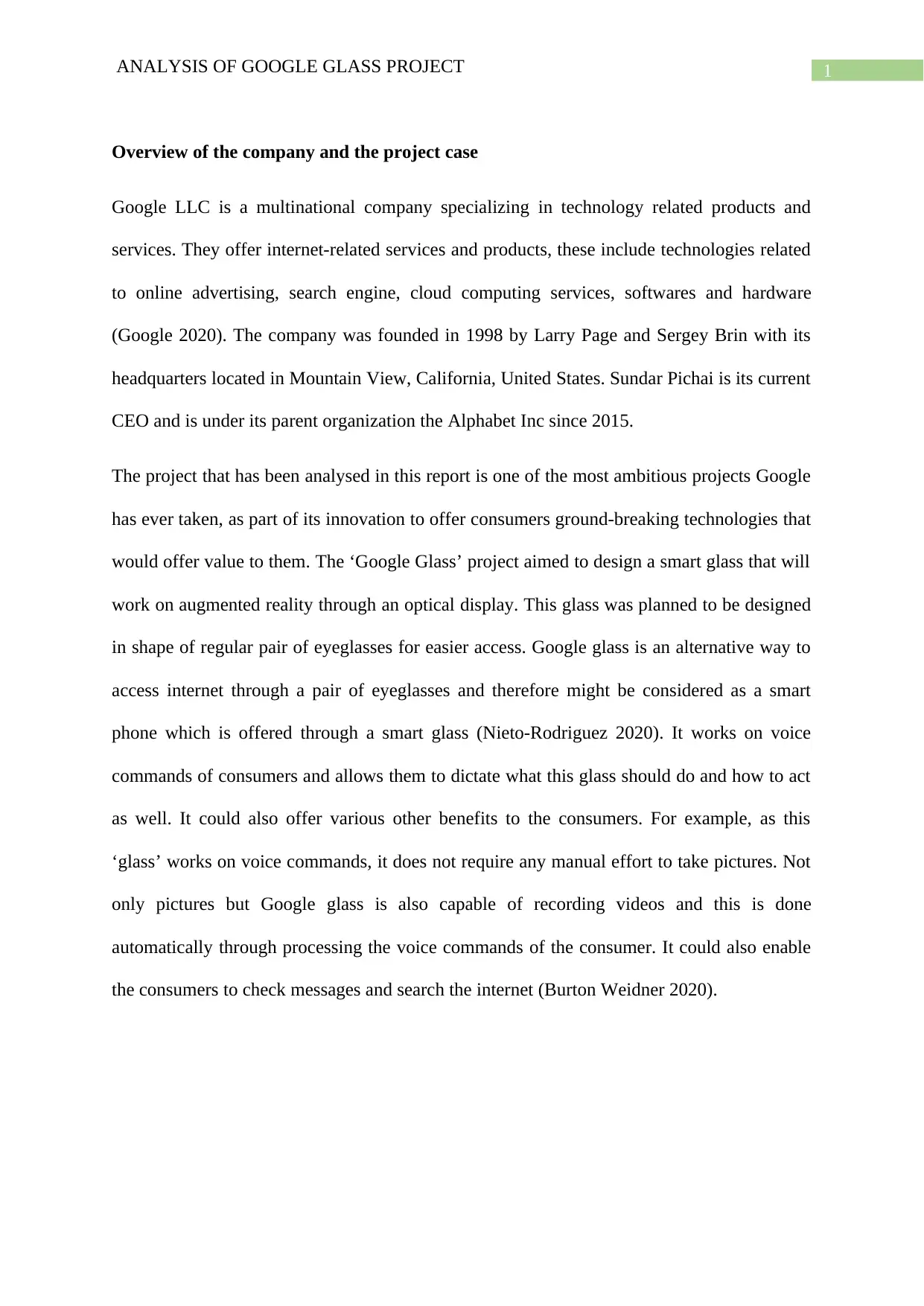
1ANALYSIS OF GOOGLE GLASS PROJECT
Overview of the company and the project case
Google LLC is a multinational company specializing in technology related products and
services. They offer internet-related services and products, these include technologies related
to online advertising, search engine, cloud computing services, softwares and hardware
(Google 2020). The company was founded in 1998 by Larry Page and Sergey Brin with its
headquarters located in Mountain View, California, United States. Sundar Pichai is its current
CEO and is under its parent organization the Alphabet Inc since 2015.
The project that has been analysed in this report is one of the most ambitious projects Google
has ever taken, as part of its innovation to offer consumers ground-breaking technologies that
would offer value to them. The ‘Google Glass’ project aimed to design a smart glass that will
work on augmented reality through an optical display. This glass was planned to be designed
in shape of regular pair of eyeglasses for easier access. Google glass is an alternative way to
access internet through a pair of eyeglasses and therefore might be considered as a smart
phone which is offered through a smart glass (Nieto-Rodriguez 2020). It works on voice
commands of consumers and allows them to dictate what this glass should do and how to act
as well. It could also offer various other benefits to the consumers. For example, as this
‘glass’ works on voice commands, it does not require any manual effort to take pictures. Not
only pictures but Google glass is also capable of recording videos and this is done
automatically through processing the voice commands of the consumer. It could also enable
the consumers to check messages and search the internet (Burton Weidner 2020).
Overview of the company and the project case
Google LLC is a multinational company specializing in technology related products and
services. They offer internet-related services and products, these include technologies related
to online advertising, search engine, cloud computing services, softwares and hardware
(Google 2020). The company was founded in 1998 by Larry Page and Sergey Brin with its
headquarters located in Mountain View, California, United States. Sundar Pichai is its current
CEO and is under its parent organization the Alphabet Inc since 2015.
The project that has been analysed in this report is one of the most ambitious projects Google
has ever taken, as part of its innovation to offer consumers ground-breaking technologies that
would offer value to them. The ‘Google Glass’ project aimed to design a smart glass that will
work on augmented reality through an optical display. This glass was planned to be designed
in shape of regular pair of eyeglasses for easier access. Google glass is an alternative way to
access internet through a pair of eyeglasses and therefore might be considered as a smart
phone which is offered through a smart glass (Nieto-Rodriguez 2020). It works on voice
commands of consumers and allows them to dictate what this glass should do and how to act
as well. It could also offer various other benefits to the consumers. For example, as this
‘glass’ works on voice commands, it does not require any manual effort to take pictures. Not
only pictures but Google glass is also capable of recording videos and this is done
automatically through processing the voice commands of the consumer. It could also enable
the consumers to check messages and search the internet (Burton Weidner 2020).
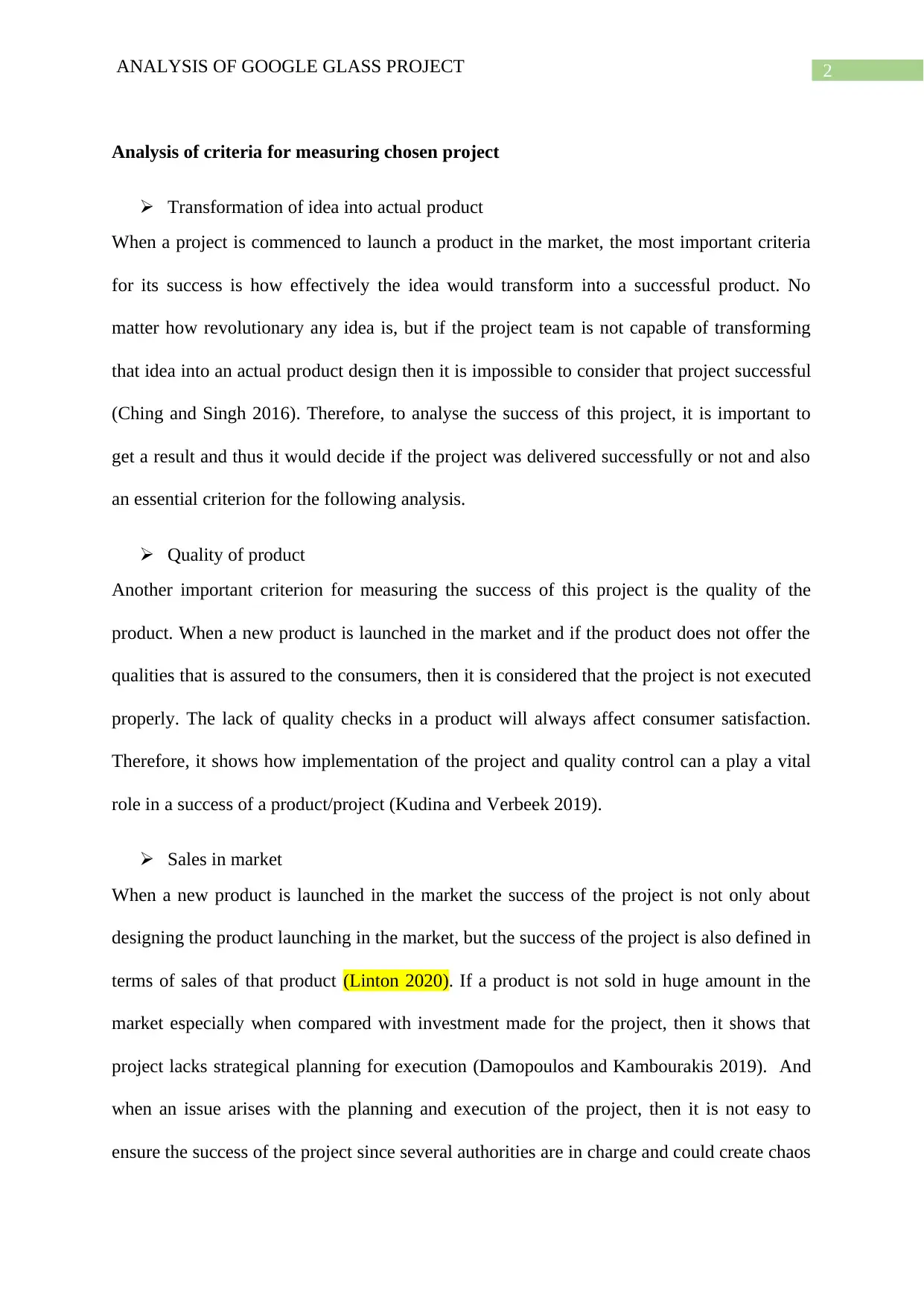
2ANALYSIS OF GOOGLE GLASS PROJECT
Analysis of criteria for measuring chosen project
Transformation of idea into actual product
When a project is commenced to launch a product in the market, the most important criteria
for its success is how effectively the idea would transform into a successful product. No
matter how revolutionary any idea is, but if the project team is not capable of transforming
that idea into an actual product design then it is impossible to consider that project successful
(Ching and Singh 2016). Therefore, to analyse the success of this project, it is important to
get a result and thus it would decide if the project was delivered successfully or not and also
an essential criterion for the following analysis.
Quality of product
Another important criterion for measuring the success of this project is the quality of the
product. When a new product is launched in the market and if the product does not offer the
qualities that is assured to the consumers, then it is considered that the project is not executed
properly. The lack of quality checks in a product will always affect consumer satisfaction.
Therefore, it shows how implementation of the project and quality control can a play a vital
role in a success of a product/project (Kudina and Verbeek 2019).
Sales in market
When a new product is launched in the market the success of the project is not only about
designing the product launching in the market, but the success of the project is also defined in
terms of sales of that product (Linton 2020). If a product is not sold in huge amount in the
market especially when compared with investment made for the project, then it shows that
project lacks strategical planning for execution (Damopoulos and Kambourakis 2019). And
when an issue arises with the planning and execution of the project, then it is not easy to
ensure the success of the project since several authorities are in charge and could create chaos
Analysis of criteria for measuring chosen project
Transformation of idea into actual product
When a project is commenced to launch a product in the market, the most important criteria
for its success is how effectively the idea would transform into a successful product. No
matter how revolutionary any idea is, but if the project team is not capable of transforming
that idea into an actual product design then it is impossible to consider that project successful
(Ching and Singh 2016). Therefore, to analyse the success of this project, it is important to
get a result and thus it would decide if the project was delivered successfully or not and also
an essential criterion for the following analysis.
Quality of product
Another important criterion for measuring the success of this project is the quality of the
product. When a new product is launched in the market and if the product does not offer the
qualities that is assured to the consumers, then it is considered that the project is not executed
properly. The lack of quality checks in a product will always affect consumer satisfaction.
Therefore, it shows how implementation of the project and quality control can a play a vital
role in a success of a product/project (Kudina and Verbeek 2019).
Sales in market
When a new product is launched in the market the success of the project is not only about
designing the product launching in the market, but the success of the project is also defined in
terms of sales of that product (Linton 2020). If a product is not sold in huge amount in the
market especially when compared with investment made for the project, then it shows that
project lacks strategical planning for execution (Damopoulos and Kambourakis 2019). And
when an issue arises with the planning and execution of the project, then it is not easy to
ensure the success of the project since several authorities are in charge and could create chaos
⊘ This is a preview!⊘
Do you want full access?
Subscribe today to unlock all pages.

Trusted by 1+ million students worldwide
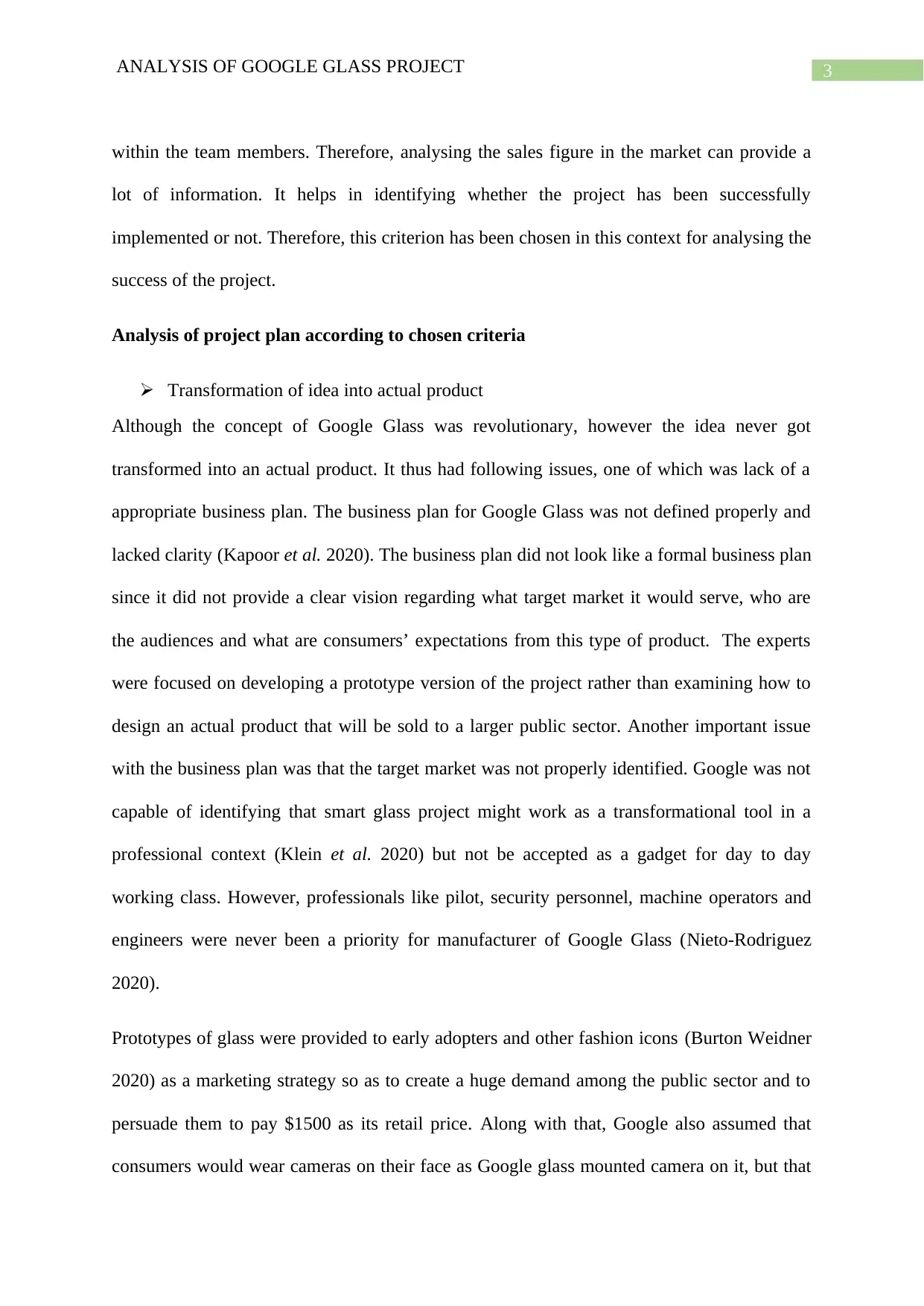
3ANALYSIS OF GOOGLE GLASS PROJECT
within the team members. Therefore, analysing the sales figure in the market can provide a
lot of information. It helps in identifying whether the project has been successfully
implemented or not. Therefore, this criterion has been chosen in this context for analysing the
success of the project.
Analysis of project plan according to chosen criteria
Transformation of idea into actual product
Although the concept of Google Glass was revolutionary, however the idea never got
transformed into an actual product. It thus had following issues, one of which was lack of a
appropriate business plan. The business plan for Google Glass was not defined properly and
lacked clarity (Kapoor et al. 2020). The business plan did not look like a formal business plan
since it did not provide a clear vision regarding what target market it would serve, who are
the audiences and what are consumers’ expectations from this type of product. The experts
were focused on developing a prototype version of the project rather than examining how to
design an actual product that will be sold to a larger public sector. Another important issue
with the business plan was that the target market was not properly identified. Google was not
capable of identifying that smart glass project might work as a transformational tool in a
professional context (Klein et al. 2020) but not be accepted as a gadget for day to day
working class. However, professionals like pilot, security personnel, machine operators and
engineers were never been a priority for manufacturer of Google Glass (Nieto-Rodriguez
2020).
Prototypes of glass were provided to early adopters and other fashion icons (Burton Weidner
2020) as a marketing strategy so as to create a huge demand among the public sector and to
persuade them to pay $1500 as its retail price. Along with that, Google also assumed that
consumers would wear cameras on their face as Google glass mounted camera on it, but that
within the team members. Therefore, analysing the sales figure in the market can provide a
lot of information. It helps in identifying whether the project has been successfully
implemented or not. Therefore, this criterion has been chosen in this context for analysing the
success of the project.
Analysis of project plan according to chosen criteria
Transformation of idea into actual product
Although the concept of Google Glass was revolutionary, however the idea never got
transformed into an actual product. It thus had following issues, one of which was lack of a
appropriate business plan. The business plan for Google Glass was not defined properly and
lacked clarity (Kapoor et al. 2020). The business plan did not look like a formal business plan
since it did not provide a clear vision regarding what target market it would serve, who are
the audiences and what are consumers’ expectations from this type of product. The experts
were focused on developing a prototype version of the project rather than examining how to
design an actual product that will be sold to a larger public sector. Another important issue
with the business plan was that the target market was not properly identified. Google was not
capable of identifying that smart glass project might work as a transformational tool in a
professional context (Klein et al. 2020) but not be accepted as a gadget for day to day
working class. However, professionals like pilot, security personnel, machine operators and
engineers were never been a priority for manufacturer of Google Glass (Nieto-Rodriguez
2020).
Prototypes of glass were provided to early adopters and other fashion icons (Burton Weidner
2020) as a marketing strategy so as to create a huge demand among the public sector and to
persuade them to pay $1500 as its retail price. Along with that, Google also assumed that
consumers would wear cameras on their face as Google glass mounted camera on it, but that
Paraphrase This Document
Need a fresh take? Get an instant paraphrase of this document with our AI Paraphraser
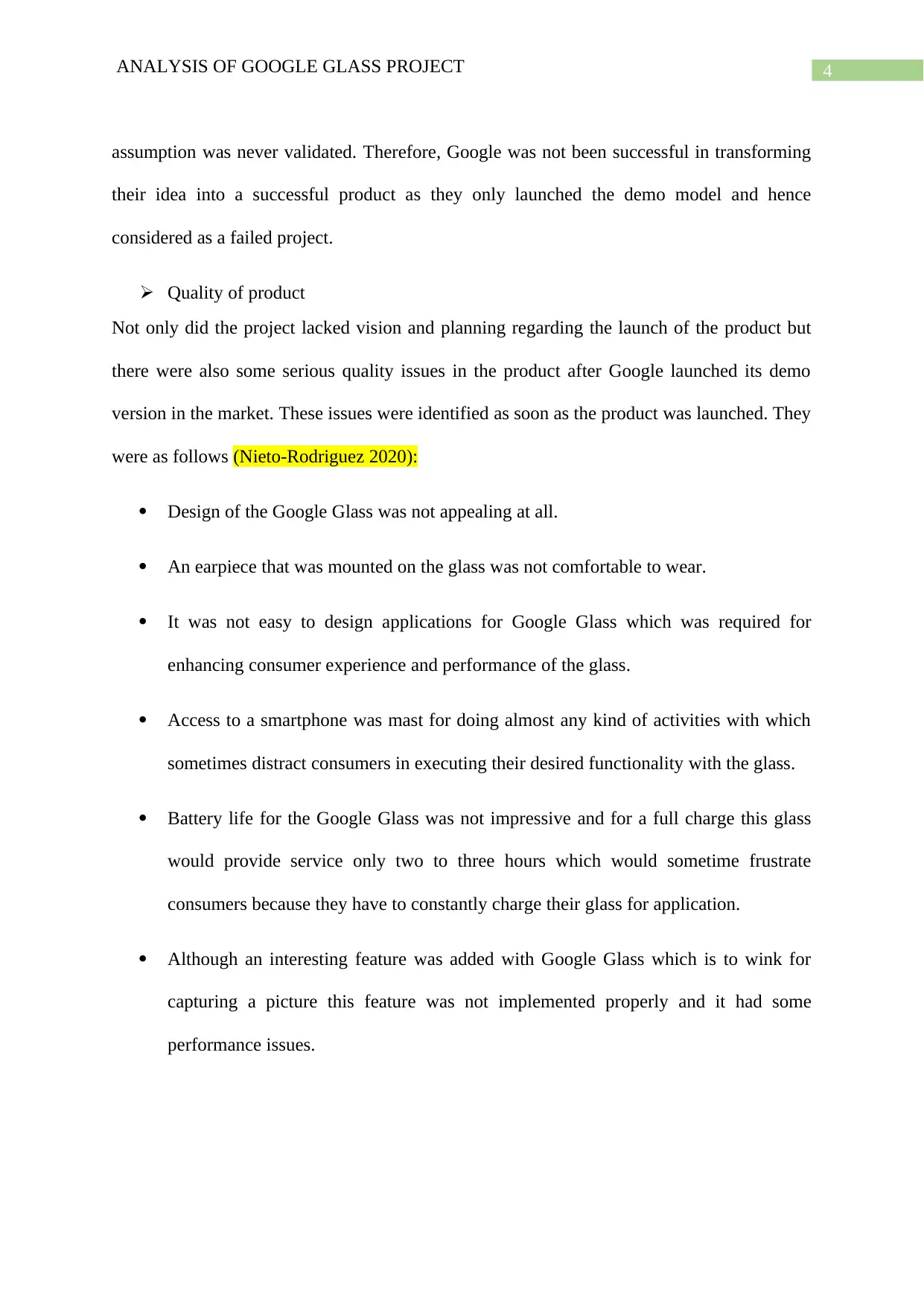
4ANALYSIS OF GOOGLE GLASS PROJECT
assumption was never validated. Therefore, Google was not been successful in transforming
their idea into a successful product as they only launched the demo model and hence
considered as a failed project.
Quality of product
Not only did the project lacked vision and planning regarding the launch of the product but
there were also some serious quality issues in the product after Google launched its demo
version in the market. These issues were identified as soon as the product was launched. They
were as follows (Nieto-Rodriguez 2020):
Design of the Google Glass was not appealing at all.
An earpiece that was mounted on the glass was not comfortable to wear.
It was not easy to design applications for Google Glass which was required for
enhancing consumer experience and performance of the glass.
Access to a smartphone was mast for doing almost any kind of activities with which
sometimes distract consumers in executing their desired functionality with the glass.
Battery life for the Google Glass was not impressive and for a full charge this glass
would provide service only two to three hours which would sometime frustrate
consumers because they have to constantly charge their glass for application.
Although an interesting feature was added with Google Glass which is to wink for
capturing a picture this feature was not implemented properly and it had some
performance issues.
assumption was never validated. Therefore, Google was not been successful in transforming
their idea into a successful product as they only launched the demo model and hence
considered as a failed project.
Quality of product
Not only did the project lacked vision and planning regarding the launch of the product but
there were also some serious quality issues in the product after Google launched its demo
version in the market. These issues were identified as soon as the product was launched. They
were as follows (Nieto-Rodriguez 2020):
Design of the Google Glass was not appealing at all.
An earpiece that was mounted on the glass was not comfortable to wear.
It was not easy to design applications for Google Glass which was required for
enhancing consumer experience and performance of the glass.
Access to a smartphone was mast for doing almost any kind of activities with which
sometimes distract consumers in executing their desired functionality with the glass.
Battery life for the Google Glass was not impressive and for a full charge this glass
would provide service only two to three hours which would sometime frustrate
consumers because they have to constantly charge their glass for application.
Although an interesting feature was added with Google Glass which is to wink for
capturing a picture this feature was not implemented properly and it had some
performance issues.
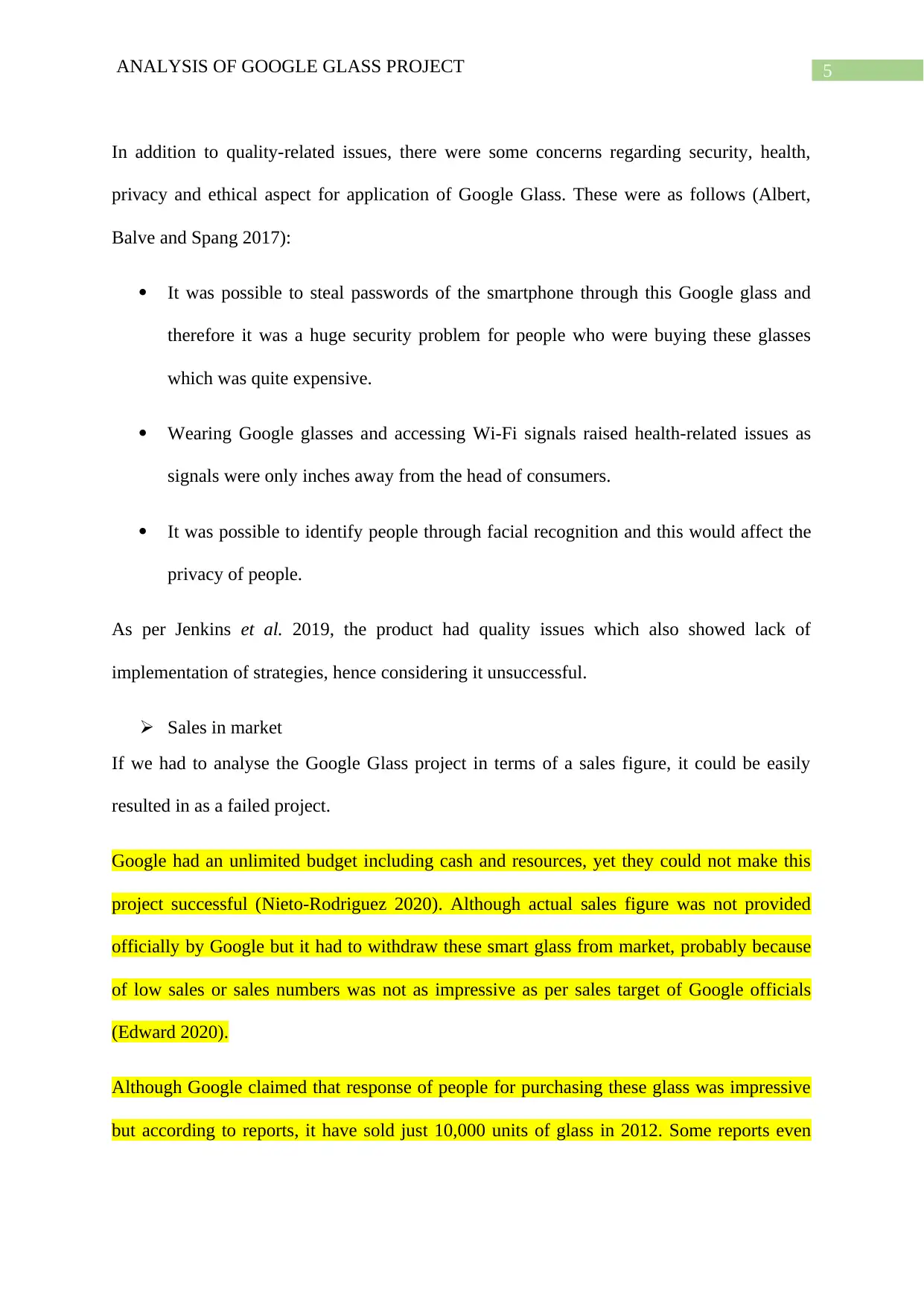
5ANALYSIS OF GOOGLE GLASS PROJECT
In addition to quality-related issues, there were some concerns regarding security, health,
privacy and ethical aspect for application of Google Glass. These were as follows (Albert,
Balve and Spang 2017):
It was possible to steal passwords of the smartphone through this Google glass and
therefore it was a huge security problem for people who were buying these glasses
which was quite expensive.
Wearing Google glasses and accessing Wi-Fi signals raised health-related issues as
signals were only inches away from the head of consumers.
It was possible to identify people through facial recognition and this would affect the
privacy of people.
As per Jenkins et al. 2019, the product had quality issues which also showed lack of
implementation of strategies, hence considering it unsuccessful.
Sales in market
If we had to analyse the Google Glass project in terms of a sales figure, it could be easily
resulted in as a failed project.
Google had an unlimited budget including cash and resources, yet they could not make this
project successful (Nieto-Rodriguez 2020). Although actual sales figure was not provided
officially by Google but it had to withdraw these smart glass from market, probably because
of low sales or sales numbers was not as impressive as per sales target of Google officials
(Edward 2020).
Although Google claimed that response of people for purchasing these glass was impressive
but according to reports, it have sold just 10,000 units of glass in 2012. Some reports even
In addition to quality-related issues, there were some concerns regarding security, health,
privacy and ethical aspect for application of Google Glass. These were as follows (Albert,
Balve and Spang 2017):
It was possible to steal passwords of the smartphone through this Google glass and
therefore it was a huge security problem for people who were buying these glasses
which was quite expensive.
Wearing Google glasses and accessing Wi-Fi signals raised health-related issues as
signals were only inches away from the head of consumers.
It was possible to identify people through facial recognition and this would affect the
privacy of people.
As per Jenkins et al. 2019, the product had quality issues which also showed lack of
implementation of strategies, hence considering it unsuccessful.
Sales in market
If we had to analyse the Google Glass project in terms of a sales figure, it could be easily
resulted in as a failed project.
Google had an unlimited budget including cash and resources, yet they could not make this
project successful (Nieto-Rodriguez 2020). Although actual sales figure was not provided
officially by Google but it had to withdraw these smart glass from market, probably because
of low sales or sales numbers was not as impressive as per sales target of Google officials
(Edward 2020).
Although Google claimed that response of people for purchasing these glass was impressive
but according to reports, it have sold just 10,000 units of glass in 2012. Some reports even
⊘ This is a preview!⊘
Do you want full access?
Subscribe today to unlock all pages.

Trusted by 1+ million students worldwide
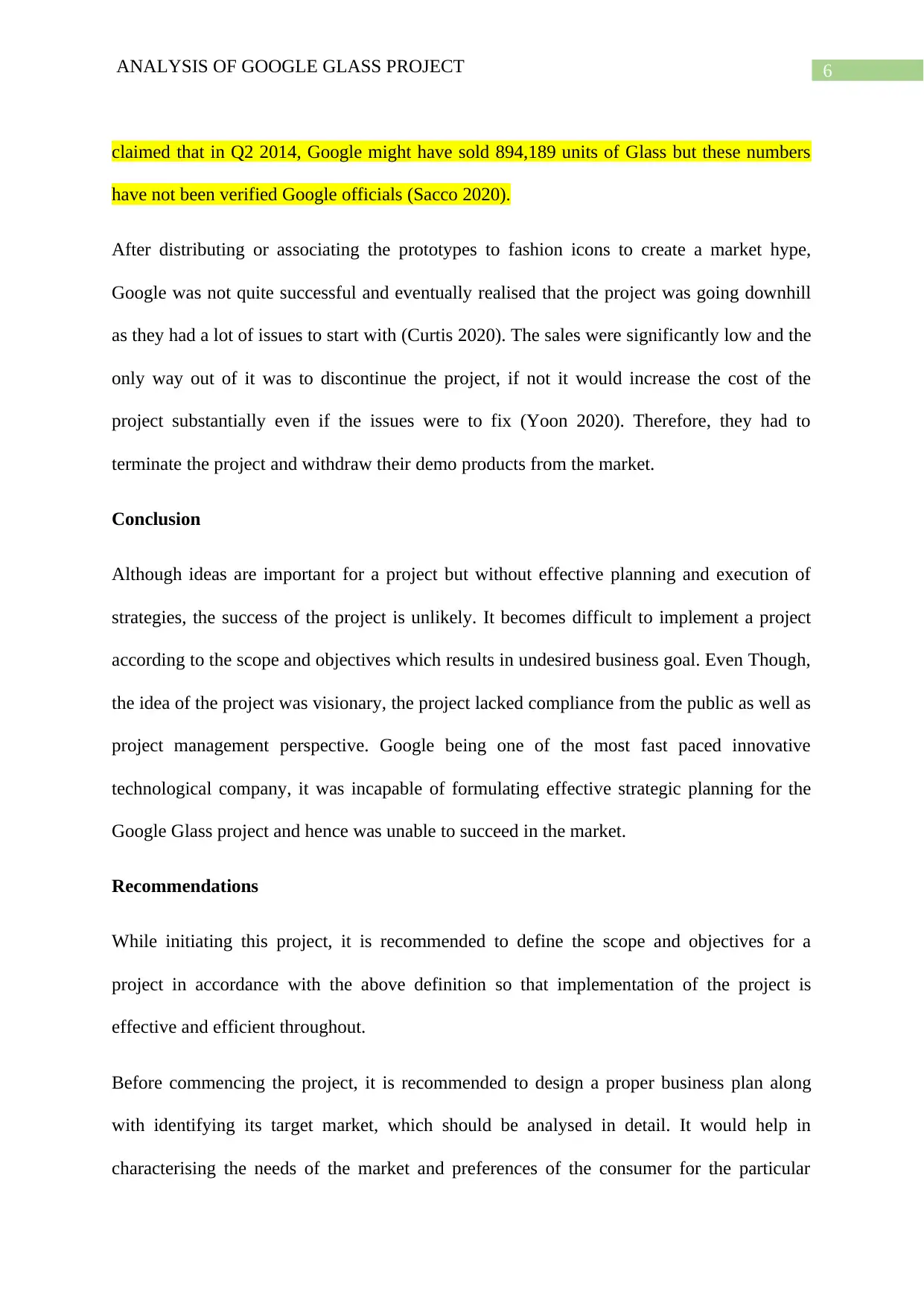
6ANALYSIS OF GOOGLE GLASS PROJECT
claimed that in Q2 2014, Google might have sold 894,189 units of Glass but these numbers
have not been verified Google officials (Sacco 2020).
After distributing or associating the prototypes to fashion icons to create a market hype,
Google was not quite successful and eventually realised that the project was going downhill
as they had a lot of issues to start with (Curtis 2020). The sales were significantly low and the
only way out of it was to discontinue the project, if not it would increase the cost of the
project substantially even if the issues were to fix (Yoon 2020). Therefore, they had to
terminate the project and withdraw their demo products from the market.
Conclusion
Although ideas are important for a project but without effective planning and execution of
strategies, the success of the project is unlikely. It becomes difficult to implement a project
according to the scope and objectives which results in undesired business goal. Even Though,
the idea of the project was visionary, the project lacked compliance from the public as well as
project management perspective. Google being one of the most fast paced innovative
technological company, it was incapable of formulating effective strategic planning for the
Google Glass project and hence was unable to succeed in the market.
Recommendations
While initiating this project, it is recommended to define the scope and objectives for a
project in accordance with the above definition so that implementation of the project is
effective and efficient throughout.
Before commencing the project, it is recommended to design a proper business plan along
with identifying its target market, which should be analysed in detail. It would help in
characterising the needs of the market and preferences of the consumer for the particular
claimed that in Q2 2014, Google might have sold 894,189 units of Glass but these numbers
have not been verified Google officials (Sacco 2020).
After distributing or associating the prototypes to fashion icons to create a market hype,
Google was not quite successful and eventually realised that the project was going downhill
as they had a lot of issues to start with (Curtis 2020). The sales were significantly low and the
only way out of it was to discontinue the project, if not it would increase the cost of the
project substantially even if the issues were to fix (Yoon 2020). Therefore, they had to
terminate the project and withdraw their demo products from the market.
Conclusion
Although ideas are important for a project but without effective planning and execution of
strategies, the success of the project is unlikely. It becomes difficult to implement a project
according to the scope and objectives which results in undesired business goal. Even Though,
the idea of the project was visionary, the project lacked compliance from the public as well as
project management perspective. Google being one of the most fast paced innovative
technological company, it was incapable of formulating effective strategic planning for the
Google Glass project and hence was unable to succeed in the market.
Recommendations
While initiating this project, it is recommended to define the scope and objectives for a
project in accordance with the above definition so that implementation of the project is
effective and efficient throughout.
Before commencing the project, it is recommended to design a proper business plan along
with identifying its target market, which should be analysed in detail. It would help in
characterising the needs of the market and preferences of the consumer for the particular
Paraphrase This Document
Need a fresh take? Get an instant paraphrase of this document with our AI Paraphraser
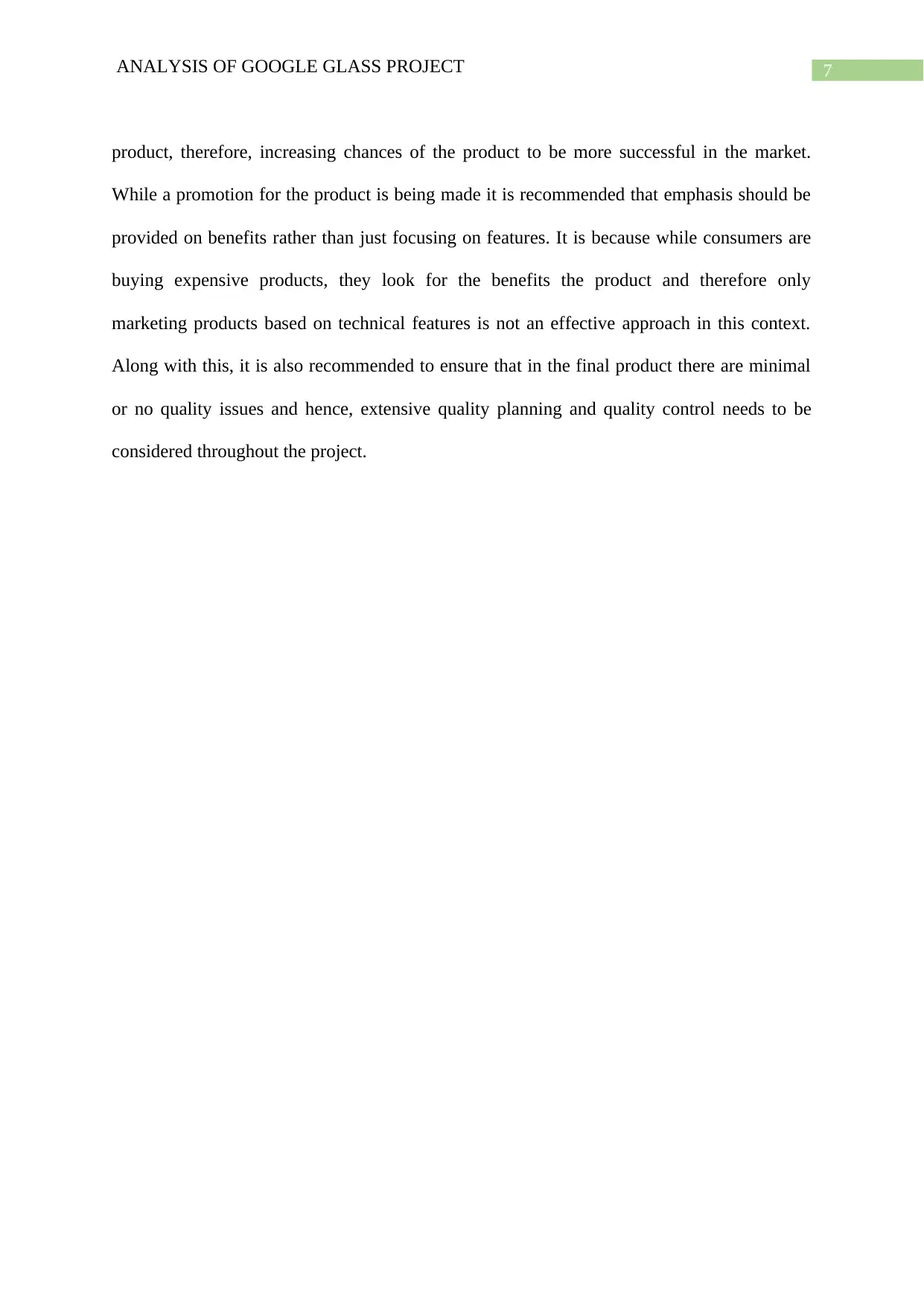
7ANALYSIS OF GOOGLE GLASS PROJECT
product, therefore, increasing chances of the product to be more successful in the market.
While a promotion for the product is being made it is recommended that emphasis should be
provided on benefits rather than just focusing on features. It is because while consumers are
buying expensive products, they look for the benefits the product and therefore only
marketing products based on technical features is not an effective approach in this context.
Along with this, it is also recommended to ensure that in the final product there are minimal
or no quality issues and hence, extensive quality planning and quality control needs to be
considered throughout the project.
product, therefore, increasing chances of the product to be more successful in the market.
While a promotion for the product is being made it is recommended that emphasis should be
provided on benefits rather than just focusing on features. It is because while consumers are
buying expensive products, they look for the benefits the product and therefore only
marketing products based on technical features is not an effective approach in this context.
Along with this, it is also recommended to ensure that in the final product there are minimal
or no quality issues and hence, extensive quality planning and quality control needs to be
considered throughout the project.
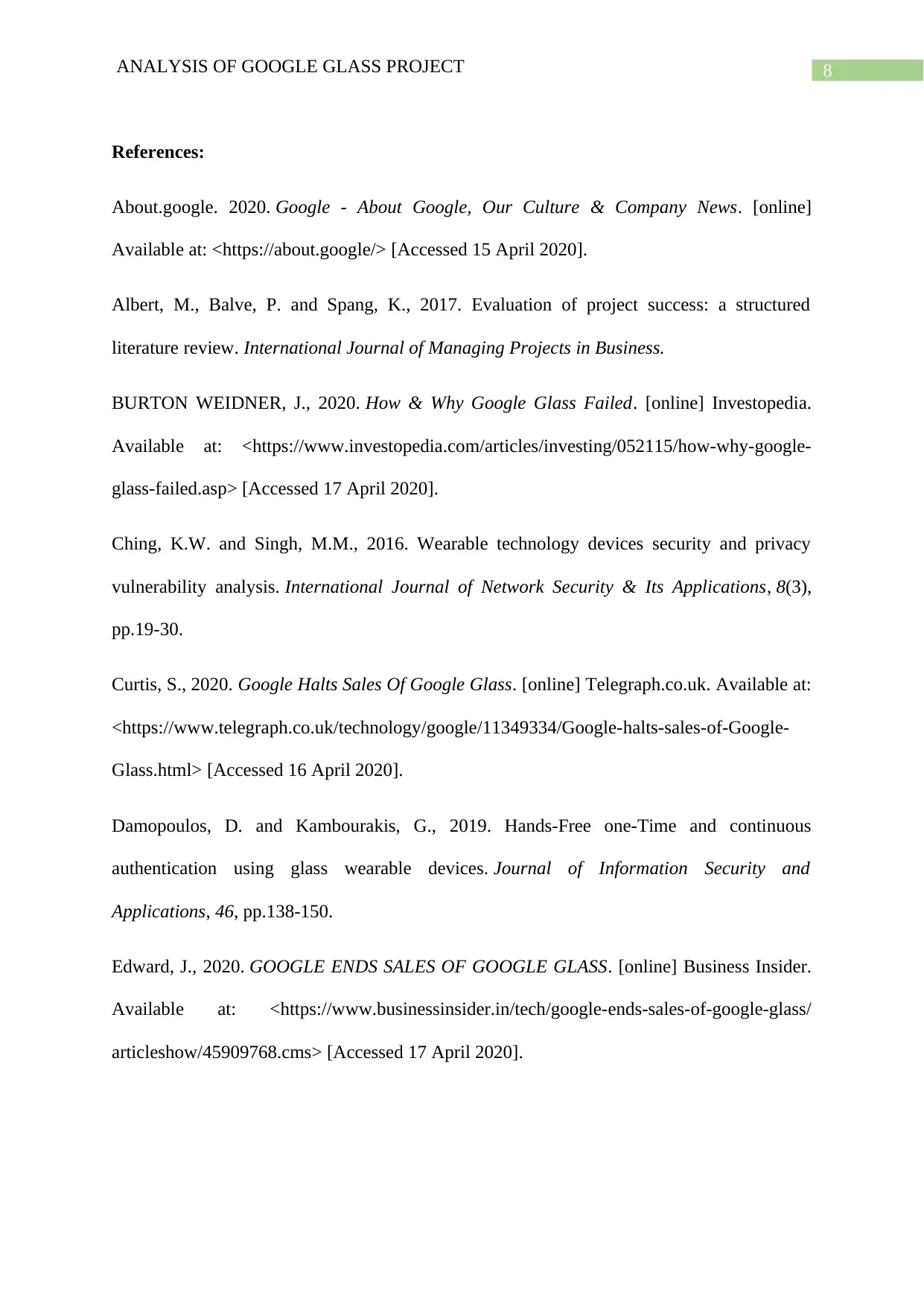
8ANALYSIS OF GOOGLE GLASS PROJECT
References:
About.google. 2020. Google - About Google, Our Culture & Company News. [online]
Available at: <https://about.google/> [Accessed 15 April 2020].
Albert, M., Balve, P. and Spang, K., 2017. Evaluation of project success: a structured
literature review. International Journal of Managing Projects in Business.
BURTON WEIDNER, J., 2020. How & Why Google Glass Failed. [online] Investopedia.
Available at: <https://www.investopedia.com/articles/investing/052115/how-why-google-
glass-failed.asp> [Accessed 17 April 2020].
Ching, K.W. and Singh, M.M., 2016. Wearable technology devices security and privacy
vulnerability analysis. International Journal of Network Security & Its Applications, 8(3),
pp.19-30.
Curtis, S., 2020. Google Halts Sales Of Google Glass. [online] Telegraph.co.uk. Available at:
<https://www.telegraph.co.uk/technology/google/11349334/Google-halts-sales-of-Google-
Glass.html> [Accessed 16 April 2020].
Damopoulos, D. and Kambourakis, G., 2019. Hands-Free one-Time and continuous
authentication using glass wearable devices. Journal of Information Security and
Applications, 46, pp.138-150.
Edward, J., 2020. GOOGLE ENDS SALES OF GOOGLE GLASS. [online] Business Insider.
Available at: <https://www.businessinsider.in/tech/google-ends-sales-of-google-glass/
articleshow/45909768.cms> [Accessed 17 April 2020].
References:
About.google. 2020. Google - About Google, Our Culture & Company News. [online]
Available at: <https://about.google/> [Accessed 15 April 2020].
Albert, M., Balve, P. and Spang, K., 2017. Evaluation of project success: a structured
literature review. International Journal of Managing Projects in Business.
BURTON WEIDNER, J., 2020. How & Why Google Glass Failed. [online] Investopedia.
Available at: <https://www.investopedia.com/articles/investing/052115/how-why-google-
glass-failed.asp> [Accessed 17 April 2020].
Ching, K.W. and Singh, M.M., 2016. Wearable technology devices security and privacy
vulnerability analysis. International Journal of Network Security & Its Applications, 8(3),
pp.19-30.
Curtis, S., 2020. Google Halts Sales Of Google Glass. [online] Telegraph.co.uk. Available at:
<https://www.telegraph.co.uk/technology/google/11349334/Google-halts-sales-of-Google-
Glass.html> [Accessed 16 April 2020].
Damopoulos, D. and Kambourakis, G., 2019. Hands-Free one-Time and continuous
authentication using glass wearable devices. Journal of Information Security and
Applications, 46, pp.138-150.
Edward, J., 2020. GOOGLE ENDS SALES OF GOOGLE GLASS. [online] Business Insider.
Available at: <https://www.businessinsider.in/tech/google-ends-sales-of-google-glass/
articleshow/45909768.cms> [Accessed 17 April 2020].
⊘ This is a preview!⊘
Do you want full access?
Subscribe today to unlock all pages.

Trusted by 1+ million students worldwide
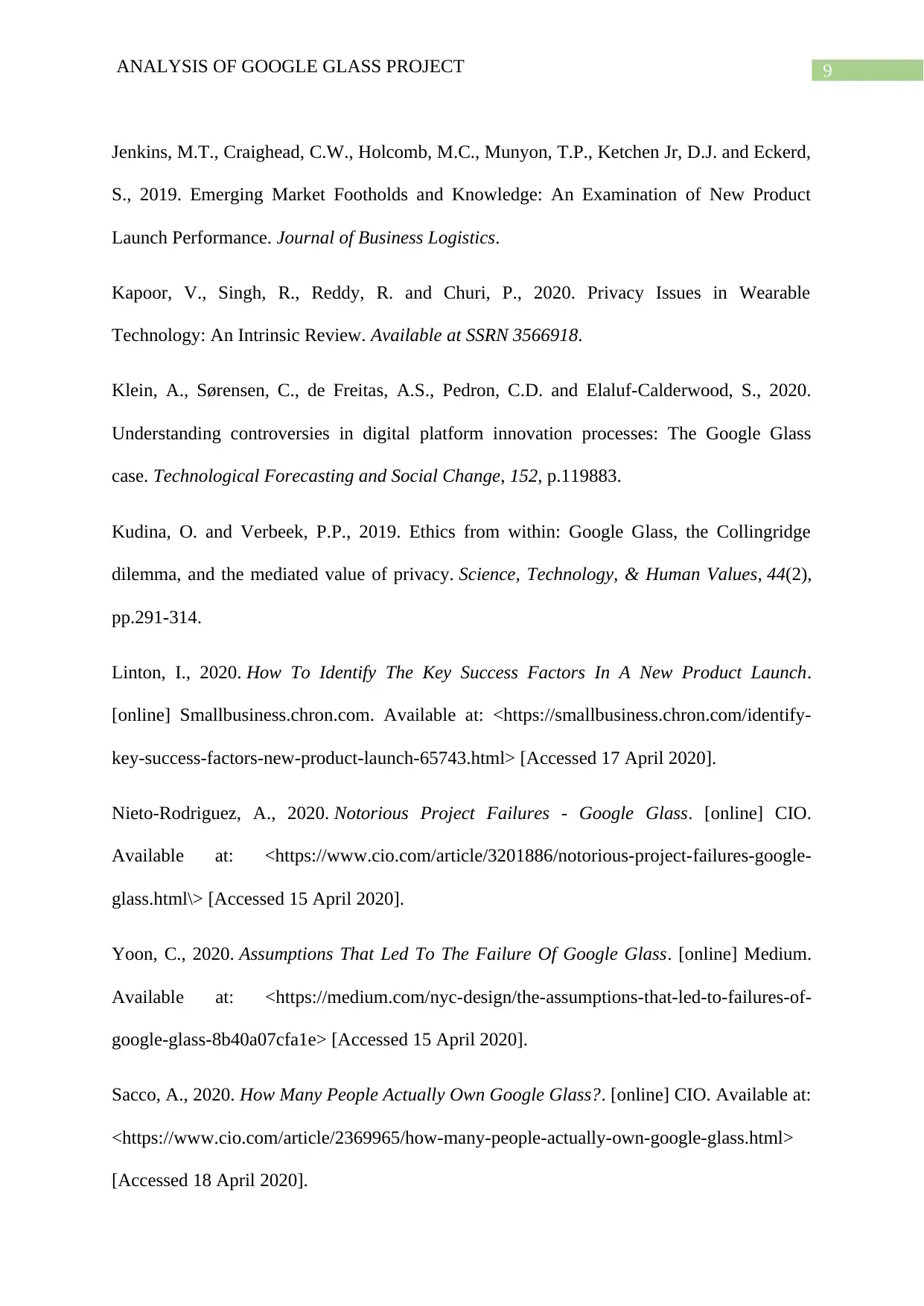
9ANALYSIS OF GOOGLE GLASS PROJECT
Jenkins, M.T., Craighead, C.W., Holcomb, M.C., Munyon, T.P., Ketchen Jr, D.J. and Eckerd,
S., 2019. Emerging Market Footholds and Knowledge: An Examination of New Product
Launch Performance. Journal of Business Logistics.
Kapoor, V., Singh, R., Reddy, R. and Churi, P., 2020. Privacy Issues in Wearable
Technology: An Intrinsic Review. Available at SSRN 3566918.
Klein, A., Sørensen, C., de Freitas, A.S., Pedron, C.D. and Elaluf-Calderwood, S., 2020.
Understanding controversies in digital platform innovation processes: The Google Glass
case. Technological Forecasting and Social Change, 152, p.119883.
Kudina, O. and Verbeek, P.P., 2019. Ethics from within: Google Glass, the Collingridge
dilemma, and the mediated value of privacy. Science, Technology, & Human Values, 44(2),
pp.291-314.
Linton, I., 2020. How To Identify The Key Success Factors In A New Product Launch.
[online] Smallbusiness.chron.com. Available at: <https://smallbusiness.chron.com/identify-
key-success-factors-new-product-launch-65743.html> [Accessed 17 April 2020].
Nieto-Rodriguez, A., 2020. Notorious Project Failures - Google Glass. [online] CIO.
Available at: <https://www.cio.com/article/3201886/notorious-project-failures-google-
glass.html\> [Accessed 15 April 2020].
Yoon, C., 2020. Assumptions That Led To The Failure Of Google Glass. [online] Medium.
Available at: <https://medium.com/nyc-design/the-assumptions-that-led-to-failures-of-
google-glass-8b40a07cfa1e> [Accessed 15 April 2020].
Sacco, A., 2020. How Many People Actually Own Google Glass?. [online] CIO. Available at:
<https://www.cio.com/article/2369965/how-many-people-actually-own-google-glass.html>
[Accessed 18 April 2020].
Jenkins, M.T., Craighead, C.W., Holcomb, M.C., Munyon, T.P., Ketchen Jr, D.J. and Eckerd,
S., 2019. Emerging Market Footholds and Knowledge: An Examination of New Product
Launch Performance. Journal of Business Logistics.
Kapoor, V., Singh, R., Reddy, R. and Churi, P., 2020. Privacy Issues in Wearable
Technology: An Intrinsic Review. Available at SSRN 3566918.
Klein, A., Sørensen, C., de Freitas, A.S., Pedron, C.D. and Elaluf-Calderwood, S., 2020.
Understanding controversies in digital platform innovation processes: The Google Glass
case. Technological Forecasting and Social Change, 152, p.119883.
Kudina, O. and Verbeek, P.P., 2019. Ethics from within: Google Glass, the Collingridge
dilemma, and the mediated value of privacy. Science, Technology, & Human Values, 44(2),
pp.291-314.
Linton, I., 2020. How To Identify The Key Success Factors In A New Product Launch.
[online] Smallbusiness.chron.com. Available at: <https://smallbusiness.chron.com/identify-
key-success-factors-new-product-launch-65743.html> [Accessed 17 April 2020].
Nieto-Rodriguez, A., 2020. Notorious Project Failures - Google Glass. [online] CIO.
Available at: <https://www.cio.com/article/3201886/notorious-project-failures-google-
glass.html\> [Accessed 15 April 2020].
Yoon, C., 2020. Assumptions That Led To The Failure Of Google Glass. [online] Medium.
Available at: <https://medium.com/nyc-design/the-assumptions-that-led-to-failures-of-
google-glass-8b40a07cfa1e> [Accessed 15 April 2020].
Sacco, A., 2020. How Many People Actually Own Google Glass?. [online] CIO. Available at:
<https://www.cio.com/article/2369965/how-many-people-actually-own-google-glass.html>
[Accessed 18 April 2020].
1 out of 10
Your All-in-One AI-Powered Toolkit for Academic Success.
+13062052269
info@desklib.com
Available 24*7 on WhatsApp / Email
![[object Object]](/_next/static/media/star-bottom.7253800d.svg)
Unlock your academic potential
Copyright © 2020–2025 A2Z Services. All Rights Reserved. Developed and managed by ZUCOL.